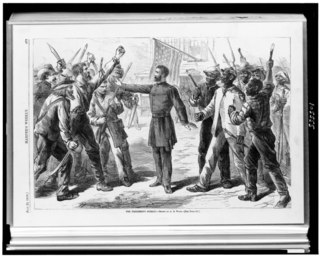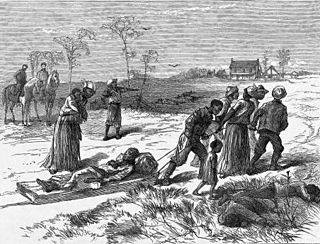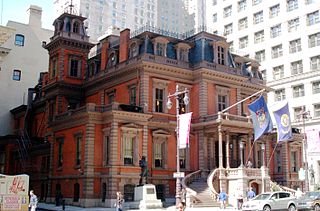Related Research Articles

The Reconstruction era was a period in American history following the American Civil War (1861–1865); it lasted from 1865 to 1877 and marked a significant chapter in the history of civil rights in the United States. Reconstruction, as directed by Congress, abolished slavery and ended the remnants of Confederate secession in the Southern states. It proclaimed the newly freed slaves citizens with (ostensibly) the same civil rights as those of whites; these rights were nominally guaranteed by three new constitutional amendments: the 13th, 14th, and 15th, collectively known as the Reconstruction Amendments. Reconstruction also refers to the general attempt by Congress to transform the 11 former Confederate states and refers to the role of the Union states in that transformation.
The Radical Republicans were a faction within the Republican Party, originating from the party's founding in 1854, some 6 years before the Civil War, until the Compromise of 1877, which effectively ended Reconstruction. They called themselves "Radicals" because of their goal of immediate, complete, and permanent eradication of slavery, without compromise. They were opposed during the War by the Moderate Republicans, and by the pro-slavery and anti-Reconstruction Democratic Party as well as liberals in the Northern United States during Reconstruction. Radicals led efforts after the war to establish civil rights for former slaves and fully implement emancipation. After weaker measures in 1866 resulted in violence against former slaves in the rebel states, Radicals pushed the Fourteenth Amendment and statutory protections through Congress. They opposed allowing ex-Confederate officers to retake political power in the Southern United States, and emphasized equality, civil rights and voting rights for the "freedmen", i.e., former slaves who had been freed during or after the Civil War by the Emancipation Proclamation and the Thirteenth Amendment.

The Bureau of Refugees, Freedmen, and Abandoned Lands, usually referred to as simply the Freedmen's Bureau, was an agency of early Reconstruction, assisting freedmen in the South. It was established on March 3, 1865, and operated briefly as a U.S. government agency, from 1865 to 1872, after the American Civil War, to direct "provisions, clothing, and fuel...for the immediate and temporary shelter and supply of destitute and suffering refugees and freedmen and their wives and children".

In the history of the United States, carpetbagger is a largely historical term used by Southerners to describe opportunistic Northerners who came to the Southern states after the American Civil War, who were perceived to be exploiting the local populace for their own financial, political, and/or social gain. The term broadly included both individuals who sought to promote Republican politics and individuals who saw business and political opportunities because of the chaotic state of the local economies following the war. In practice, the term carpetbagger was often applied to any Northerners who were present in the South during the Reconstruction Era (1865–1877). The term is closely associated with "scalawag", a similarly pejorative word used to describe native white Southerners who supported the Republican Party-led Reconstruction.

The Colfax massacre, sometimes referred to by the euphemism Colfax riot, occurred on Easter Sunday, April 13, 1873, in Colfax, Louisiana, the parish seat of Grant Parish. An estimated 62–153 black militia men were murdered while surrendering to a mob of former Confederate soldiers and members of the Ku Klux Klan. Three white men also died in the confrontation.

Eric Foner is an American historian. He writes extensively on American political history, the history of freedom, the early history of the Republican Party, African-American biography, the American Civil War, Reconstruction, and historiography, and has been a member of the faculty at the Columbia University Department of History since 1982. He is the author of several popular textbooks. According to the Open Syllabus Project, Foner is the most frequently cited author on college syllabi for history courses.

The Redeemers were a political coalition in the Southern United States during the Reconstruction Era that followed the Civil War. Redeemers were the Southern wing of the Democratic Party. They sought to regain their political power and enforce white supremacy. Their policy of Redemption was intended to oust the Radical Republicans, a coalition of freedmen, "carpetbaggers", and "scalawags". They generally were led by the White yeomanry and they dominated Southern politics in most areas from the 1870s to 1910.
The Mississippi Plan of 1875 was developed by white Southern Democrats as part of the white insurgency during the Reconstruction Era in the Southern United States. It was devised by the Democratic Party in that state to overthrow the Republican Party in Mississippi by means of organized threats of violence and suppression or purchase of the black vote. Democrats wanted to regain political control of the legislature and governor's office. Their success in doing so led to similar plans being adopted by white Democrats in South Carolina and other majority-black states.
The Coushatta massacre (1874) was an attack by members of the White League, a white supremacist paramilitary organization composed of white Southern Democrats, on Republican officeholders and freedmen in Coushatta, the parish seat of Red River Parish, Louisiana. They assassinated six white Republicans and five to 20 freedmen who were witnesses.

The Union Leagues were quasi-secretive men’s clubs established during the American Civil War (1861–1865) to promote loyalty to the Union of the United States of America, the policies of newly elected 16th President Abraham Lincoln, and to combat what they believed to be the treasonous words and actions of anti-war, anti-black "Copperhead" Democrats. Though initially nonpartisan, by the war's last year they were in open alliance with the Republican Party, pro-Union Democrats, and the Union military. The most famous of these clubs were formed in Philadelphia, New York, and Boston and were composed of prosperous men who raised money for war-related service organizations, such as the United States Sanitary Commission, which provided medical care to treat Federal soldiers wounded in battle at a time when the military was ill-prepared for the scale of need. The clubs supported the Republican Party with funding, organizational support, and activism. Union Leagues also existed throughout the land which were created primarily by working-class men. By the spring of 1863, these disparate councils were organized under the Union League of America (ULA) organization which was headquartered in Washington, D.C. Like-minded organizations aimed at the working class, which became known as Loyal Leagues, were also created in New York. Similar patriotic organizations also existed for women and were known as Ladies Union Leagues.

Black Reconstruction in America: An Essay Toward a History of the Part Which Black Folk Played in the Attempt to Reconstruct Democracy in America, 1860–1880 is a history of the Reconstruction era by W. E. B. Du Bois, first published in 1935. The book challenged the standard academic view of Reconstruction at the time, the Dunning School, which contended that the period was a failure and downplayed the contributions of African Americans. Du Bois instead emphasized the agency of Black people and freed slaves during the Civil War and Reconstruction and framing the period as one that held promise for a worker-ruled democracy to replace a slavery-based plantation economy.
Neoabolitionist is a term used in historiography to characterize historians of race relations motivated by the spirit of racial equality typified by the abolitionists who fought to abolish slavery in the mid-19th century. They write especially about African-American history, slavery in the United States, the American Civil War and the Reconstruction Era.
The Dunning School is a historiographical school of thought regarding the Reconstruction period of American history (1865–1877), supporting conservative elements against the Radical Republicans who introduced civil rights in the South. It is named for Columbia University professor William Archibald Dunning, who taught many of its followers.
The ten percent plan, formally the Proclamation of Amnesty and Reconstruction, was a United States presidential proclamation issued on December 8, 1863, by United States President Abraham Lincoln, during the American Civil War. By this point in the war, the Union Army had pushed the Confederate Army out of several regions of the South, and some Confederate states were ready to have their governments rebuilt. Lincoln's plan established a process through which this postwar reconstruction could come about.
William Archibald Dunning was an American historian and political scientist at Columbia University noted for his work on the Reconstruction era of the United States. He founded the informal Dunning School of interpreting the Reconstruction era through his own writings and the Ph.D. dissertations of his numerous students. Dunning has been criticized for advocating white supremacist interpretations, his "blatant use of the discipline of history for reactionary ends" and for offering "scholarly legitimacy to the disenfranchisement of southern blacks and to the Jim Crow system."

James M. Hinds was an American politician who represented Arkansas in the United States House of Representatives for the 2nd congressional district from June 24, 1868, until his assassination four months later by a Klansman. Hinds was an advocate of civil rights for former slaves.
In the United States, a freedmen's town was an African-American municipality or community built by freedmen, former slaves who were emancipated during and after the American Civil War. These towns emerged in a number of states, most notably Texas. They are also known as freedom colonies, from the title of a book by Sitton and Conrad.

This is a selected bibliography of the main scholarly books and articles of Reconstruction, the period after the American Civil War, 1863–1877.
Historiography examines how the past has been viewed or interpreted. Historiographic issues about the American Civil War include the name of the war, the origins or causes of the war, and President Abraham Lincoln's views and goals regarding slavery.
The civil rights movement (1865–1896) aimed to eliminate racial discrimination against African Americans, improve their educational and employment opportunities, and establish their electoral power, just after the abolition of slavery in the United States. The period from 1865 to 1895 saw a tremendous change in the fortunes of the black community following the elimination of slavery in the South.
References
- ↑ McFeely, William S. (1988-05-22). "A Moment of Terrifying Promise". The New York Times . Archived from the original on 2021-03-17. Retrieved 2021-03-17.
I found letters from ordinary people received by governors in a half-dozen Southern states [...] Ten years ago, when I began, I was a visiting professor at the University of South Carolina. The governors' papers there alone consisted of 121 boxes. The letters told me what was going on in people's minds because they came from all classes - former slaves, members of the Ku Klux Klan, white farmers, black leaders. They went to the grass roots of life."..."Mine isn't statistical but analytical history. I didn't use computers because great issues are not susceptible to analysis by the numbers.
- ↑ McFeely, William S. (1988-05-22). "A Moment of Terrifying Promise". The New York Times . Archived from the original on 2021-03-17. Retrieved 2021-03-26.
[Foner's] synthesis is the product not only of a dauntingly thorough reading of this large body of literature, but also of his own extensive research. The result is a compelling narrative that begins during the Civil War as slaves sought freedom by escaping from their pursuing masters and coming into Union Army camps.
- ↑ Nash, Gary (1988-10-16). "1988 Book Prize Winner: History: The Killing of 'Birth of a Nation.'". Los Angeles Times . Archived from the original on 2021-03-26. Retrieved 2021-03-26.
Eric Foner’s long, brilliant and stylish book […] is of signal importance, not only to understanding one of the most controversial periods in American history but to comprehending the course of race relations in this country during the last century.
- ↑ Pole, J.R. (1990-01-11). "During the war and after the war". London Review of Books. 12 (1). Archived from the original on 2020-10-24. Retrieved 2020-10-24.
Earlier interpretations of the history of Reconstruction by Stampp and Franklin did much to lay down guidelines for the ‘Second Reconstruction’ school, whose approach reflected the mood of the modern civil rights movement: but Foner has brought under control an enormously greater mass of information.
- ↑ "Book Prizes – Los Angeles Times Festival of Books» 1988 Los Angeles Times Book Prize Winners". Los Angeles Times . 2014-01-04. Archived from the original on 2014-01-04. Retrieved 2014-01-04.
History Reconstruction: America’s Unfinished Revolution, 1863-1877 by Eric Foner (Harper & Row)
- ↑ Foner, Eric (1990-01-01). A Short History of Reconstruction, 1863-1877. archive.org. Harper & Row. ISBN 9780060964313.